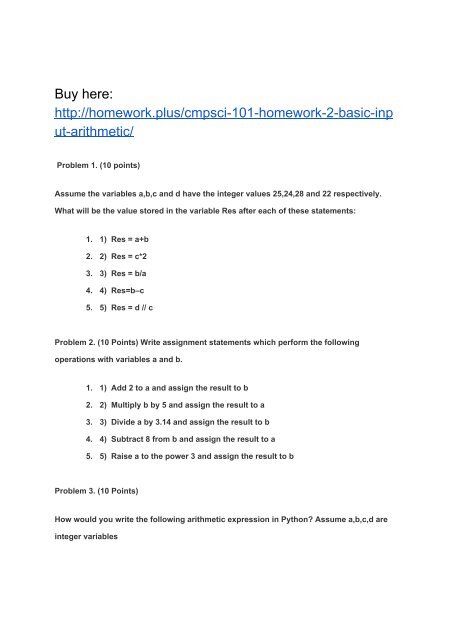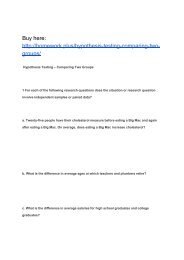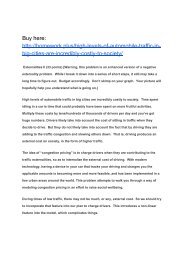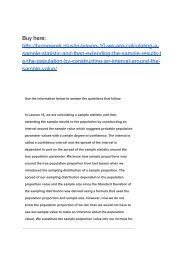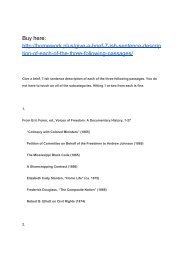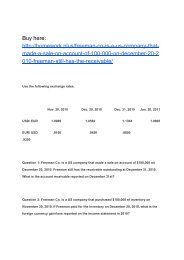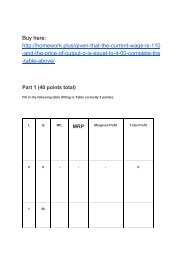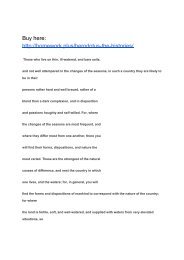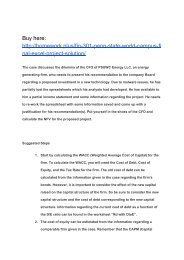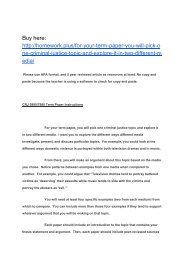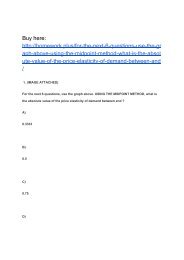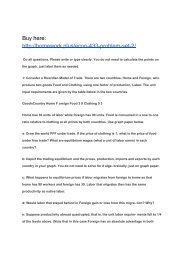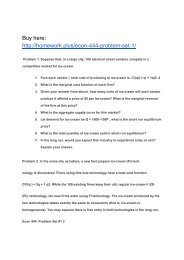CMPSCI 101 Homework 2 – Basic Input & Arithmetic
CMPSCI 101 Homework 2 – Basic Input & Arithmetic
CMPSCI 101 Homework 2 – Basic Input & Arithmetic
Create successful ePaper yourself
Turn your PDF publications into a flip-book with our unique Google optimized e-Paper software.
Buy here:<br />
http://homework.plus/cmpsci-<strong>101</strong>-homework-2-basic-inp<br />
ut-arithmetic/<br />
Problem 1. (10 points)<br />
Assume the variables a,b,c and d have the integer values 25,24,28 and 22 respectively.<br />
What will be the value stored in the variable Res after each of these statements:<br />
1. 1) Res = a+b<br />
2. 2) Res = c*2<br />
3. 3) Res = b/a<br />
4. 4) Res=b<strong>–</strong>c<br />
5. 5) Res = d // c<br />
Problem 2. (10 Points) Write assignment statements which perform the following<br />
operations with variables a and b.<br />
1. 1) Add 2 to a and assign the result to b<br />
2. 2) Multiply b by 5 and assign the result to a<br />
3. 3) Divide a by 3.14 and assign the result to b<br />
4. 4) Subtract 8 from b and assign the result to a<br />
5. 5) Raise a to the power 3 and assign the result to b<br />
Problem 3. (10 Points)<br />
How would you write the following arithmetic expression in Python? Assume a,b,c,d are<br />
integer variables
4/3(r+34)<strong>–</strong>9(a+bc)+(3+d(2+a))/a+bd<br />
Problem 4. (10 Points) Evaluate the following expressions using the order of operators.<br />
(Show the steps involved)<br />
1) 9+6*(5+7)/3<strong>–</strong>7 2) 19<strong>–</strong>6/(8-3) *2-1<br />
For example evaluating 10 + 3*(8-4) <strong>–</strong> 5 involve the following steps:<br />
10 + 3 * 4 <strong>–</strong> 5 10 + 12 <strong>–</strong> 5 17<br />
Problem 5.<br />
Write a program which displays the following tab separated table a b a**b<br />
238<br />
4 5 1024<br />
5 6 15625<br />
Problem 6.<br />
(10 Points)<br />
Write a program which asks the user to enter the temperature in Celsius and converts it to<br />
Fahrenheit.<br />
Use the formula F = 5/9C + 32, where F is the temperature in Fahrenheit and C is the<br />
temperature in Celsius.<br />
Sample program output:<br />
Please enter the temperature in Celsius: 9 The temperature in Fahrenheit is: 37
(10 Points)<br />
Problem 7. (20 Points)<br />
Write a program which asks the user to enter an integer between 0 and 100 and outputs<br />
the sum of the digits of the number entered.<br />
Hint: You can use the modulo operator to extract digits (93%10 = 3) and the integer<br />
division operator to remove digits (91//10 = 9).<br />
Sample program output:<br />
Please enter a number between 0 and 100: 89<br />
The sum of the digits is: 17<br />
Problem 8. (20 Points)<br />
Write a program which asks the user to enter an 8 digit number and outputs the number<br />
reversed.<br />
Hint: You can use the modulo operator to extract digits (93%10 = 3) and the integer<br />
division operator to remove digits (91//10 = 9).<br />
Sample program output:<br />
Please enter a number: 89123231 The reverse is: 13232198<br />
Problem 9. (EXTRA CREDIT/OPTIONAL) (25 Points) Write a program which asks the user<br />
to enter a 6 bit binary number and outputs the number’s decimal<br />
equivalent.<br />
Hint: We can obtain the bits (digits) of a binary number similarly to the previous two<br />
questions by using the modulo and integer division operators. Converting a number from
inary to decimal involves multiplying the bits with increasing powers of 2 and adding the<br />
result.<br />
For example for the 2 bit binary number 10 the bits 1 and 0 are multiplied by 21 and 20<br />
respectively resulting in 21 x 1 + 20 x 0 = 2. Thus the decimal equivalent of 10 is 2.<br />
Similarly for the 4 bit binary number <strong>101</strong>1 the bits 1, 0, 1, 1 are multiplied by 23, 22, 21<br />
and20 respectively resulting in 23 X 1 + 22 X 0 + 21 X 1 + 20 X 1 = 11. Thus the decimal<br />
equivalent of <strong>101</strong>1 is 11.<br />
For a 6 digit binary number assuming the bits are b5 through b0 the decimal equivalent of<br />
the binary number b5 b4 b3 b2 b1 b0 is given by b5 X 25+ b4 X 24+ b3 X 23+ b2 X 22+ b1 X<br />
21+ b0 X 20<br />
Some other examples are<br />
(binary)111→22 X1+21 X1+20 X1→7(decimal) (binary)10001→24 X1+23 X0+22 X0+21 X0+20<br />
X1→17(decimal) (binary)<strong>101</strong>00→24 X1+23 X0+22 X1+21 X0+20 X0→20(decimal) Sample<br />
program output:<br />
Please enter a 6 bit binary number: <strong>101</strong>010<br />
The decimal equivalent is: 42


